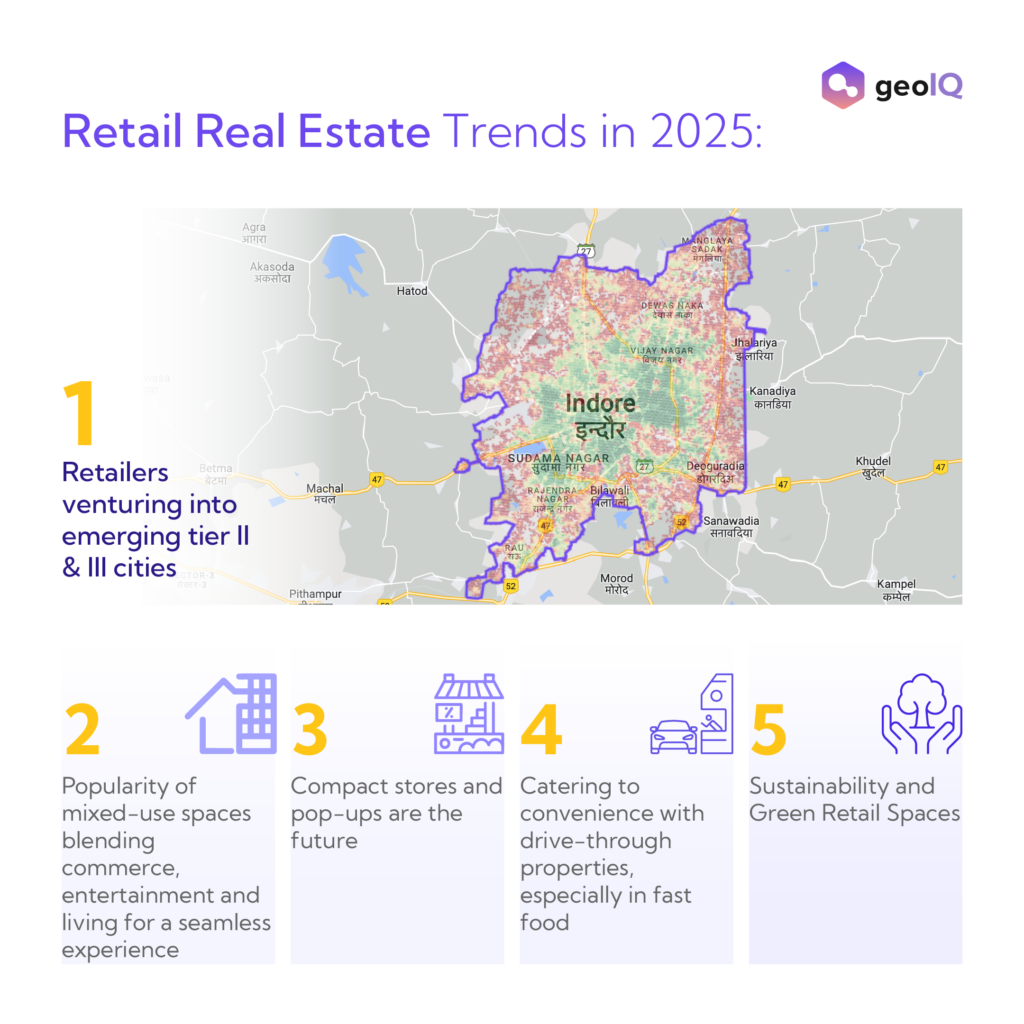The retail and real estate sectors are in constant flux, changing as consumer preferences shift and market dynamics change.
As businesses and developers look for new opportunities, the trends in retail real estate will reflect how the landscape is adapting to meet the demands of both consumers and retailers.
This article lists the top retail real estate trends in India and how retail businesses can pick a site that suits their needs.
7 Retail Real Estate Trends

1. Focus on Mixed-Use Developments
Mixed-use developments are transforming the urban infrastructure while aiming to provide unique living experiences for professionals.
These projects usually combine residential spaces, offices, or retail areas, within proximity or within the same buildings, creating vibrant hubs that attract constant foot traffic.
New retail real estate projects in major cities incorporated mixed-use formats, and this retail real estate trend is expected to grow further.
For example, developments like DLF CyberHub in Gurgaon, Phoenix MarketCity in Bangalore, and Forum Mall in Chennai include high-end apartments, office spaces, or shopping areas, offering convenience and boosting retail sales.
Such projects cater to time-pressed professionals who prefer to “live, work, play” environments.
2. Expanding into Tier 2 and Tier 3 Cities
Developers and retailers are increasingly looking to expand their footprint to Tier II and Tier III cities as some major markets have reached saturation point or to start a business in an untapped market. These are Tier II and III cities like Indore, Coimbatore, and Lucknow.
According to JLL India, North India is leading the way in upcoming retail real estate supply in Tier II and III cities, making up 44% of the total. Cities like Ludhiana, Jaipur, and Lucknow are driving this growth. Southern India follows with 30%, with places like Coimbatore, Mallapuram, Thrissur, and Trivandrum taking the lead.
While expanding to these cities and markets, retail businesses have to ensure that the location is right for their business and has enough customer density to cater.
For such retailers and developers, GeoIQ’s location intelligence platform aids by helping them pick perfect locations across Tier I, Tier II cities, and beyond based on foot traffic, location demographics, competition analysis, complementary brands, and many other crucial location data.
3. Increase in Organized Retail Space
The demand for organized retail spaces is at an all-time high.
Cities like Hyderabad, Pune, and Bangalore are witnessing a boom in mall developments, with many organized retail projects focused on leisure and entertainment options such as malls, multiplexes, etc.
Also, a joint report by Unicommerce and Wazir Advisors states that organized retail contributed 12% of India’s overall retail market in 2022. This is expected to grow to 15% in 2025 with increased penetration in Tier II and Tier III cities.
This meteoric rise of organized retail also aligns with the growing aspirations of middle-class and upper-middle-class consumers, particularly in metro and Tier 2 cities.
4. Flexible Rental Agreements
Retailers and landlords are adapting to changing market dynamics by embracing flexible rental agreements.
These arrangements are particularly appealing to new businesses or established brands testing new markets, as these can reduce the financial risks associated with long-term leases.
For instance, some agreements now include revenue-sharing models where rent is tied to store performance, allowing retailers to balance costs during slower months.
This retail real estate trend highlights a win-win situation, as landlords attract a wider variety of tenants, and retailers enjoy the flexibility to adapt and grow without being tied down to rigid leases.
Businesses entering new markets can leverage location intelligence to assess the average rent of a location across India to pick a perfect location that suits their business.
5. Drive-through Properties for Restaurants
Drive-through spaces are becoming an emerging real estate trend for restaurants in India.
With people constantly on the go, quick and convenient dining options are in demand, and drive-through setups are perfectly meeting this need.
What started as a fast-food trend with giants like McDonald’s and KFC has now expanded to include Starbucks, which introduced its first drive-through in India at Dhillon Plaza on the Chandigarh-Ambala highway, and Domino’s, offering quick pick-up options.
Though these aren’t expanded heavily yet, you can spot these outlets along highways, near business hubs, or in urban areas where traffic never stops.
6. Expansion of Luxury Retail Spaces
One of the results of increasing disposable income in India is the rise of demand for luxury products consumption.
The country’s luxury retail market is growing at a compound annual growth rate (CAGR) of 4.3%, with cities like Mumbai and Delhi seeing a surge in demand for premium retail spaces.
Luxury brands such as Louis Vuitton, Gucci, and Chanel are expanding their footprint by opening flagship stores in India’s top malls. So, we can confidently assume that we’ll witness many retail spaces specialized for luxury brands in the coming years.
7. Sustainability in Retail Development
Along with mixed-use developments that help cut down on carbon footprints, developers in India are putting a stronger focus on sustainable property projects.
This trend is tied closely to the green building movement. Over 11,000 projects across India—commercial spaces included—are certified under green standards and now feature energy-efficient materials and renewable energy sources like solar panels.
As consumers increasingly choose brands that are committed to sustainability, retailers are likely to invest in these green spaces to adapt and to be green-friendly.
Conclusion
These retail real estate trends are expected to grow in the coming years as market dynamics and consumer expectations continue to grow.
This indicates that now, more than ever, businesses need to leverage location intelligence to their advantage, helping them identify the ideal locations for their ventures.


